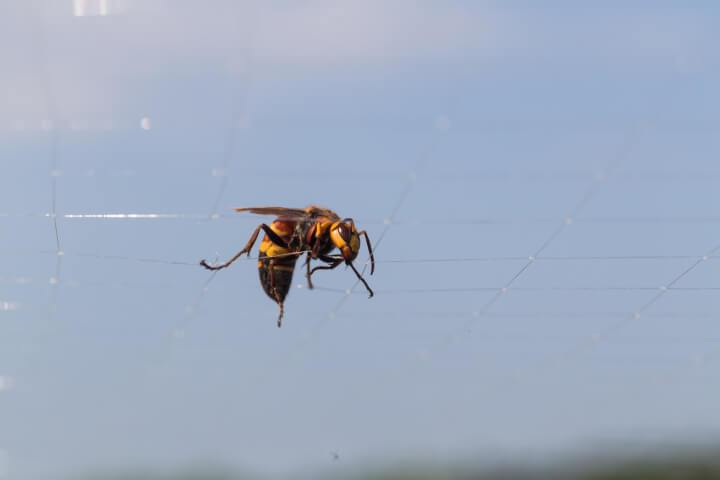


Have you encountered every insect species like the Asian hornet, Asian giant hornet, bald faced hornet, European hornet, European giant hornet, yellow jacket (yellowjacket/meat bees), paper wasp, foraging wasp, fruit fly, and a bunch of other stinging insects? Unless you're a beekeeper, probably not. Because the most common types most people heard of are the wasp, beneficial honeybees, bees, and hornet. And finding ways to get rid of or trap them can be tricky, especially if you can’t identify which is which. These stingers refer to the same order of insects, but they’re not the same as common insects regarding what they eat, where they live, and how likely they are to sting you.
So how do wasps and hornets differ? For now, let's try to determine the difference between the wasp and a hornet like their appearance, behavior, and diet. More so, we should also know the best wasp and hornet traps.
Learn More: How to Get Rid of Hornets Naturally
| Appearance | Behavior | Diet | |
Wasps | They’re around one-third inch to one inch in length. | The yellow jackets are very hostile, but the paper wasps aren’t likely to sting unless threatened. | Prey on other pests and are very inclined to scavenge for sweets & proteins |
Hornets | Hornets are slender and long. Their color ranges from brown with yellow stripes or hints of red, to metallic green or blue. Their texture is smooth and hairless. | Very hostile when the nest is disturbed; many stinging individuals | Prey on other insects and usually scavenge for protein and sweets. |
Wasps are terrifying to many people who have been stung with wasp stings. Nonetheless, we can say they’re beneficial insects since their main job is to consume other insects. Wasps' main attractant is protein (raw meat) and sweets, making those summertime picnics less than comfortable. Sprays and baits are beneficial, but most contain toxins that may not be good around your family.
A safer way to reduce the pest insects is to use a bit of DIY wasp trap. Homemade wasp trap, hornet trap, and hummingbird feeders instructions are accessible on the internet. You can also purchase ready-made versions of fly trap, yellowjacket trap, sticky trap, reusable trap, yellow jacket trap, multiple traps, and whatnot.
a. RESCUE! TrapStik for Wasps, Mud Daubers, Carpenter Bees
RESCUE! has many insect-related products on shelves, but one of their most famous for wasps would be their Trap Stik, which keeps away carpenter bees and mud daubers. With multi-dimensional patterns and colors, these traps attract wasps to their sticky surfaces. It also comes without wasp spray, so there are no odors or chemicals.
b. Mowham Solar Powered Wasp Traps
These solar-powered wasp traps can be used repeatedly and don't use anything toxic to run.
c. RESCUE! Reusable Yellowjacket Trap
This is a reusable wasp trap that's more eco-friendly since you can purchase refills for it.
d. Stingmon Hanging Outdoor Wasp Trap 2-Pack
These attractive traps are created like no other. With a gourd-shaped silhouette, the trap has various tunnels, drawing in wasps with the odor of the beeswax bait. The added channels allow the smell of the bait to spread further, which then lures in more wasps or hornets into your trapped insects collection.
e. ANPHSIN 6-Pack Hanging Fake Wasp Nest Eco-Friendly Decoy
These clever traps are made from bamboo fiber and cotton blend and are designed to mimic a wasp's nest. They come in a six-pack, so you'll have many to last you through the summer. The materials are more durable than an average paper, which gives longer-lasting shelf life.
f. Darware Glass Wasp Traps
Glass wasp traps are one of the most uncomplicated solutions to trapping wasps and have the most minimalist look. This package comes with two traps and needs fruit juice or sugar water to be poured into the bottom. A wire hanger is also added, which makes setup easy.
g. TERRO Wasp and Hornet Killer Foaming Spray
This is more of a nest solution and less of an individual wasp trap. Terro offers an affordable 19 oz. foam wasp and hornet killer spray. This product makes the nest totally coated. The formulation is water-based and safe for both indoors and outdoors use.
h. PIC Yellow Jacket and Wasp Traps (6-Pack)
These wasp traps are packaged in 6-pack, so you don't have to buy them repeatedly when the first few run out. Unlike the rest, these are particularly meant for outdoor usage and use a cage mechanism rather than sticky glue.
i. Handcraft Peppermint Essential Oil
While dish soap and vinegar are effective solutions to deal with wasps, peppermint essential oil is also a life-saver as far as these invasive insects are concerned.
Some homemade wasp traps effectively trapped and killed wasps, meat bees, hornets, and yellow jackets.
What can you do to lessen the number of wasps in your yard even more? Make an easy DIY Hornet Trap! So simple and effective!
These are cost-efficient and highly effective and will soon be filled with trapped insects, dead wasps, hornets, yellow jackets, and so on.
There are no sure-fire solutions to ensure that the colony will thoroughly pack up and leave your area when it comes to DIY wasp and hornet control. While you may find many DIY answers available through the internet, most of them will do little more than put you, your family, or your pets in harm's way. If there’s a beehive or hornet nest near your home, know what hive removal techniques you should practice to avoid painful stings, harm to your home, and the return of these insects.
Your intuition may be to grab a nearby hose and start spraying, but drowning a hive isn’t a foolproof answer. When bees are sprayed with water, they become provoked and can begin striking. Once an aggravated bee homes in on a target, you, it releases chemical pheromones that call in the colony army. This approach will also incite a hornet or yellowjacket attack.
Like water, using fire to eliminate a hornet nest or yellow jacket nest is ineffective, not to mention hazardous. This is due to the fact that most of their nests are made from pulps of chewed-up wood, making them flammable. But, if you succeed in getting near enough to set fire to a hive, you could run the chance of spreading the flame, which could cause unchangeable damage to both you and your property.
Moreover, trying to destroy a honeybee or hornet nest with a baseball bat, large stick, or any other pole-like object will put you right behind the dangerous lines. When you stand too close to the colony, particularly that of the baldfaced hornet, which will strike anyone or anything that invades its space, the likelihood of you being stung multiple times rises. This DIY method of nest removal is too hazardous for those allergic to insect stings, as anaphylactic shock could happen in just seconds.
If you're allergic to any stinging insects, don’t try to knock a nest down on your own unless it isn't that huge (palm-sized or less), but if the nest is bigger than a fist, don’t even think about it. Alternatively, call a professional. It's the best and most reliable way to get rid of a nest and any potential danger.
Wasps and hornets are unpredictable, so don't take any risks, even if it appears most of them are dead insects.

No matter which stinging insect is near, you shouldn’t try to deal with the pests on your own. Confronting a hornet nest or honey bee hive could incite these pests to defend their colony. It's best to call for help from experienced professionals who can identify and safely eliminate these stinging pests before they infest your home.
If you’re concerned about hornets or bees around you, your home, and your family, get in touch with PermaKill Exterminating today and see what our professional pest control experts can do to make your lovely home and business free from all these pests.